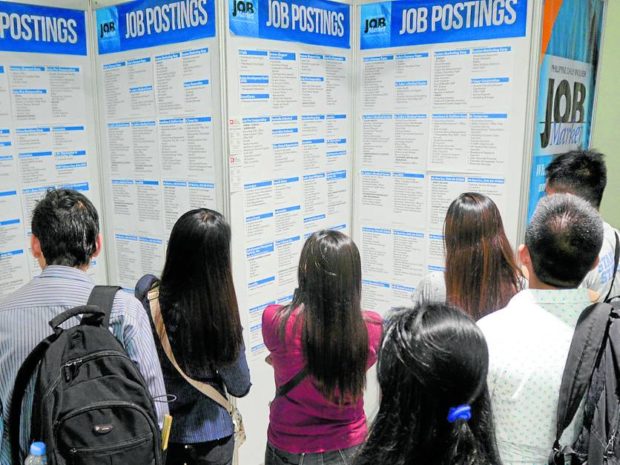Jobless Pinoys increase to 3.27M

FEWER JOBS Job seekers check out the listings at a career expo in Mandaluyong City before the pandemic. —FILE PHOTO
The country’s unemployment rate was pegged at 6.6 percent in December last year, slightly higher than 6.5 percent in November—the lowest since it hit 17.6 percent in April 2020 when the first hard lockdown was imposed due to the COVID-19 pandemic.
The Philippine Statistics Authority (PSA) said in its latest Labor Force Survey (LFS) report on Thursday that the total number of unemployed persons in December was estimated at 3.27 million, higher by 113,000 from the 3.16 million reported in the previous month.
In April 2020, there were 7.2 million unemployed Filipinos.
For the whole of 2021, the PSA estimated that there were 3.7 million people looking for jobs who did not get hired. This was an improvement from the 4.5 million unemployed in 2020 during the first year of the pandemic, but still worse than 2019 when 2.26 million people could not find work.
National statistician Dennis Mapa said in a press briefing that the uptick in December was due to an increase in the labor force participation rate—65.1 percent in December compared to 64.2 percent in November.
Article continues after this advertisementThis meant that more Filipinos aged 15 years and older actively looked for a job.
Article continues after this advertisementAccording to Mapa, an additional 910,000 people in the labor force took part in the job market.
On the right track
During the holiday season, the government eased mobility restrictions, allowing more people to go out and more businesses to operate. This was before a new round of surge in COVID-19 infections hit the country in January due to the Omicron variant.
Conversely, Mapa said the country’s employment situation in December 2021 was registered at 93.4 percent, the second-highest rate since January last year.
“Employed persons increased by 797,000 in December, estimated at 46.27 million from 45.48 million in November,” he added.
At the same time, the underemployment rate was estimated at 14.7 percent in December, improving from 16.7 percent in the previous month.
Underemployed persons refer to those with jobs who want to have additional hours of work in their present job or to have an additional job, or to have a new job with longer hours of work.
According to the National Economic and Development Authority, the latest LFS signaled that the economy was on the right track to recovery, saying that in December, around 800,000 more people were able to find work as mobility restrictions were relaxed.
“By accelerating the vaccination program and safely reopening more sectors of the economy, we were able to generate more and better jobs for the people,” Economic Planning Secretary Karl Chua said in a statement.
“We look forward to building on these gains in 2022 now that we have contained the spread of Omicron and have reverted to alert level 2 in the National Capital Region and several provinces,” he added.
Employment to improve
Malacañang, on the other hand, was expecting the employment numbers to improve in the coming months since restrictions had been relaxed in most parts of the country with foreign tourists allowed to come in.
Acting presidential spokesperson Karlo Nograles said more Filipinos were expected to return to work from January onward with many parts of the country, including Metro Manila, under the more relaxed alert level 2 classification.
He added that while there were still areas under the more restrictive alert level 3, none have been elevated to alert level 4.
“We expect that for January, February, March and and so on and so forth, especially with the opening of tourism right now in February, we expect better numbers in the coming months of 2022,” Nograles said at the Laging Handa press briefing.
For Labor Secretary Silvestre Bello III, the LFS report “reflects the efforts of the government toward recovery of the labor market throughout the year.”
While there was a “slight increase” in the unemployment rate on a month-to-month basis, “the full-year employment indicators are way better in 2021 in contrast to … 2020,” he said in a statement. —WITH REPORTS FROM LEILA B. SALAVERRIA AND DONA Z. PAZZIBUGAN